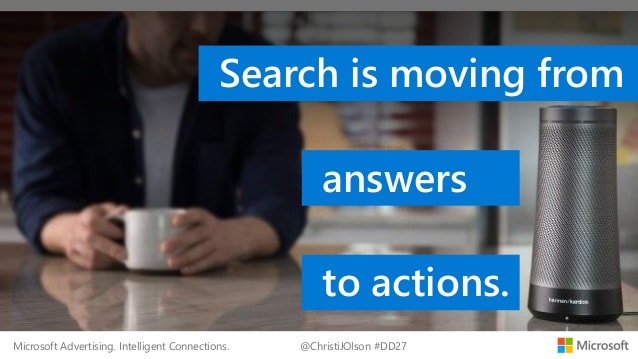How voice is changing customer behaviour and the way you do marketing
Table of contents:
- 2019 voice-assistant statistics
- 8 reasons why people use voice-assistants
- 2019 Microsoft Voice Report key insights
- 3 brands using Alexa skills to grow
- How to optimize your content for voice search
Voice is changing customer behaviour and the way we do marketing.
These changes have brought about the advent of vCommerce (voice commerce). vCommerce is the next stage of eCommerce designed to include voice shopping.
In this article, I share statistics, insights and recommendations curated from Think with Google, eMarketer and Microsoft to help you get an overall view of voice commerce and the factors underpinning its growth.
People like talking; it’s our main way of exchanging information, connecting with each other and doing things. The latest developments in machine learning allowed for the rapid growth of voice-control technology like voice assistants (Google Duplex, Alexa etc) and voice search.
Why are voice-assistants so popular?
Because they make our life easier.
When you’re preparing a new recipe for your family, it’s more convenient to get step-by-step guidance by voice than to fumble on your smartphone with your hands dirty of flour, oil or minced meat.
According to eMarketer, voice-control technology has officially moved out of the early-adopter phase and into the mainstream.
The market is expanding quickly. Is your marketing ready for it?

2019 Voice-Assistants Statistics
![]() By 2021, the number of US voice assistant users will reach 122.7 million, representing 42.2% of US internet users and 36.6% of the US population (eMarketer)
By 2021, the number of US voice assistant users will reach 122.7 million, representing 42.2% of US internet users and 36.6% of the US population (eMarketer)
![]() There will be 57.6 million female and 54.2 million male voice assistant users in the US by the end of 2019 (eMarketer)
There will be 57.6 million female and 54.2 million male voice assistant users in the US by the end of 2019 (eMarketer)
![]() 62% of those who regularly use a voice-activated speaker say they are likely to buy something through their voice-activated speaker in the next month (ThinkWithGoogle)
62% of those who regularly use a voice-activated speaker say they are likely to buy something through their voice-activated speaker in the next month (ThinkWithGoogle)
![]() 44% of those who regularly use a voice-activated speaker say they order products they need like groceries, household items, etc., at least once a week (ThinkWithGoogle)
44% of those who regularly use a voice-activated speaker say they order products they need like groceries, household items, etc., at least once a week (ThinkWithGoogle)
![]() 53% of people who own a voice-activated speaker said it feels natural talking to it (ThinkWithGoogle)
53% of people who own a voice-activated speaker said it feels natural talking to it (ThinkWithGoogle)
![]() 51% of people 55+ said a top reason for using voice-activated speakers is “it empowers me to instantly get answers and information” (ThinkWithGoogle)
51% of people 55+ said a top reason for using voice-activated speakers is “it empowers me to instantly get answers and information” (ThinkWithGoogle)
![]() 72% of parents who own voice-activated speakers said they are likely to use them to buy something in the next month, compared to 51% of non-parents (ThinkWithGoogle)
72% of parents who own voice-activated speakers said they are likely to use them to buy something in the next month, compared to 51% of non-parents (ThinkWithGoogle)
![]() Almost 70% of requests to the Google Assistant are expressed in natural language, not the typical keywords people type in a web search (ThinkWithGoogle)
Almost 70% of requests to the Google Assistant are expressed in natural language, not the typical keywords people type in a web search (ThinkWithGoogle)
![]() 80% of users reported being somewhat or very satisfied (2019 Microsoft Voice Report)
80% of users reported being somewhat or very satisfied (2019 Microsoft Voice Report)
![]() 66% of owners use them weekly (2019 Microsoft Voice Report)
66% of owners use them weekly (2019 Microsoft Voice Report)
Why are people using voice-assistants? 8 reasons according to Think with Google
- It allows them to more easily multitask.
- It enables them to do things faster than other devices.
- It empowers them to instantly get answers and information.
- It makes their daily routine easier.
- It’s in the centre of the home.
- People are getting more done with less friction.
- It offers a new, more human relationship with technology. People are engaging with their voice-activated speakers as if they were human.
- Parents are power users and shoppers. Being a parent is a full-time job, they literally have their hands full most of the time every day. So it’s easier to get other things done by talking to a voice-assistant. Parents want to find business information, call up customer service, and discover new brands using their devices. Voice-assistants are also a way to keep the kids entertained and help parents catch a break and relax for a few minutes.
2019 Microsoft Voice Report Key Insights
What started out as blue links on a search engine results page (SERP) is currently transforming into something even larger in scale and deeper in breadth. The blue links are disappearing. Keywords are disappearing. Keyboards are disappearing. What will be left?
Microsoft Voice Report 2019
Microsoft’s 2019 Voice Report analyzes the latest voice disruption.
Here are the report’s most interesting findings related to voice and voice search:
![]() Search moves from a place of answers to a state of action. Consumers are using voice search to shop, get directions, make reservations, book travel, etc.
Search moves from a place of answers to a state of action. Consumers are using voice search to shop, get directions, make reservations, book travel, etc.
![]() Voice itself is not the next big disruptor. Conversational AI has a bigger impact on consumer behaviour because it flips the user dynamic: instead of humans learning computer code, computers are learning our language.
Voice itself is not the next big disruptor. Conversational AI has a bigger impact on consumer behaviour because it flips the user dynamic: instead of humans learning computer code, computers are learning our language.
![]() Search engines are morphing into personal digital assistants.
Search engines are morphing into personal digital assistants.
![]() Even though smartphones currently outnumber smart speakers, this could also change fast as smart speakers head mainstream. Consumers find themselves putting down their phones to engage more with their smart speaker.
Even though smartphones currently outnumber smart speakers, this could also change fast as smart speakers head mainstream. Consumers find themselves putting down their phones to engage more with their smart speaker.
![]() Voice-controlled technology has crossed the chasm from early adopters into the early majority of users.
Voice-controlled technology has crossed the chasm from early adopters into the early majority of users.
![]() Voice is a replacement for keyboards and touchscreens.
Voice is a replacement for keyboards and touchscreens.
![]() vCommerce (voice commerce) is the next stage of eCommerce designed to include voice shopping. It minimizes friction, elevates ease and convenience to a new level in which there will be no going back. Why waste time by standing in line to order your custom coffee when you could tell Alexa to have it ready for in-store pickup?
vCommerce (voice commerce) is the next stage of eCommerce designed to include voice shopping. It minimizes friction, elevates ease and convenience to a new level in which there will be no going back. Why waste time by standing in line to order your custom coffee when you could tell Alexa to have it ready for in-store pickup?
![]() 35% of respondents have made a purchase using voice and they enjoyed the experience.
35% of respondents have made a purchase using voice and they enjoyed the experience.
![]() 70% believe that the digital assistants will not only help them shop but understand their preferences and make routine purchases on their behalf within 5 years.
70% believe that the digital assistants will not only help them shop but understand their preferences and make routine purchases on their behalf within 5 years.
![]() Brands will need to pay attention to how each of the digital assistants and voice technologies pull their recommendations to make sure that they don’t get left behind.
Brands will need to pay attention to how each of the digital assistants and voice technologies pull their recommendations to make sure that they don’t get left behind.
![]() vCommerce redefines shopping, repurposes the functions of a physical store, minimizes time and stress for consumers and maximizes the importance of personalization and brand loyalty.
vCommerce redefines shopping, repurposes the functions of a physical store, minimizes time and stress for consumers and maximizes the importance of personalization and brand loyalty.
![]() Retailers should create digital assistants that don’t just sell products but act as trusted resources.
Retailers should create digital assistants that don’t just sell products but act as trusted resources.
![]() Retailers should not approach voice skills and actions as shiny new things, but try to solve actual problems to create deeper relationships with their customers.
Retailers should not approach voice skills and actions as shiny new things, but try to solve actual problems to create deeper relationships with their customers.

3 brands using Alexa skills to grow
Campbell’s Kitchen skill provides users with recipes that incorporate ingredients they already have in their kitchen.
Zyrtec’s Your Daily Allergy Cast skill blends information from the local weather forecast, the pollen count and a database of the most common outdoor allergens to predict the impact on the user’s allergies.
Tide’s Stain Remover skill can help users remove just about anything from their clothing.
Curious how other brands use Alexa skills? Read These 13 brands use Alexa Skills to engage creatively with their consumers.
How to optimize your content for voice search
Write content that is both informational (“What is the best brand of paper towel?”) and action-based (“Order more paper towels.”)(Think with Google)
Write content with natural language. Voice searches are longer and more conversational than text-based search. (Think with Google)
Include filler words in question keywords – I, the, me, for. Mobile searches for “do I need” have grown over 65%. For example, “how much do I need to retire,” “what size generator do I need,” and “how much paint do I need.” This enables people to get answers quickly and efficiently and it also gives them the confidence that they’re getting exactly what they need. (Backlinko)
Marketers should lock down keywords and phrases typically associated with their businesses and then consider natural language search phrases that customers might be using to find them. (Think with Google)
Google tends to answer voice search queries with short, 29-word results. Have your content answer someone’s query in 30 words or less. (Backlinko)
Create voice search FAQ pages. Question keywords grow year over year and Google pulls answers from FAQ pages where the answer is, you guessed it, 30 words or less. (Backlinko)
Optimize for featured snippets: 40.7% of voice search answers come from the Featured Snippet. (Backlinko) Learn how to optimize your content for Google’s Featured Snippets.
Write longer content with long tail keywords. Longer content (around 2000 words) means more opportunities for Google to find a match with a voice search query. (Backlinko)
Are you going to optimize your content for voice search?
Join the Conversation
We’d love to hear what you have to say.
Get in touch with us on our LinkedIn Group, Facebook Group or Twitter.
What Voice Search And AI Mean For Your Business
By 2020, around half of all searches will be conducted through voice search.
At least, that’s what the team at SEO Tribunal discovered when it conducted extensive research into the area.
Voice search is not a novel concept. If you have a smartphone, tablet, or even a laptop, you might already have used it yourself.
There’s no question that it makes searching for things online a lot simpler. After all, why type out a query when you can just ask your device to look for the answer?
If you’re not that clued up when it comes to voice search, the infographic below will tell you all that you need to know.
In this post, however, we’re more interested in how voice search and AI will affect businesses going forward.
Are you ready to learn more?
Advances In AI Have Made Voice Search Viable
The earliest versions of personal assistants were comparatively stupid by today’s standards. You had to get the exact keyword and spelling right to get close to getting the right answer. Even then the results were not very accurate.
Today however, AI is far more advanced, making voice searches a lot more accurate. In addition, virtual assistants like Siri, Cortana, Duplex etc. can collect results on their own and give you a quick summary of what they found.
The increase in the capabilities of these assistants has led to the creation of smart devices, such as smart speakers. These devices make full use of voice recognition software and can become a hub in the home.
All you have to do is to say the magic phrase, like Hello Google and your speaker will be activated. From there, you can run a voice search or tell your assistant to play music, for example.
What’s Does This Mean for Your Business?
Well, for starters, it means that your site must be optimized for voice search. But don’t let that stress you out too much, it’s not that much of a departure from what you are doing already. What you need to do is to start thinking as someone would if using a voice query.
Queries Are Changing
When we try to type out a query we tend to be a bit more economical with the number of words we use. We aim to use the minimum number of words because that means less typing. This further means that it’s a lot easier to narrow down the number of keywords to target.
With voice search, the opposite is true. We simply phrase the query as we normally would. It means that the number of keywords that might be used increases a lot. Also, the queries will take the form of questions, rather than simple phrases.
How to Prepare for Voice Search
It is actually a lot easier to optimize content for voice search than you might think.
You’ll need to think about the types of questions that people might ask in relation to your business, and then incorporate these into your site.
Setting up a comprehensive FAQ page is a good way to get started. But you can also start to incorporate more question style content on your site. So, for example, you could create a post titled,” What process do we use?” instead of “The Process We Use.”
It’s a subtle distinction, but one that better matches the format of queries to come. It will also work well when it comes to typed queries, so it’s not going to hurt your results now either.
Consistency Is Essential
There is one area where voice search could hurt business though, and that’s when it comes to the aggregated content provided.
Let’s say that someone asks Google for information about music shops in the area. Google will create a summary of the information based on numerous sources. What Google cannot do, however, is check that the information is correct. It could be a problem for you if there is info out there that is incorrect.
Say, for example, that your business was listed in a few online directories and then you moved. It isn’t a problem for you, you just update the information on your site. But Google will still pick up that old information and could present it in its findings. This means that the searcher could receive your old address and telephone number. And who do you think they’ll blame because the info is incorrect? That’s right – your business.
To get around this, run regular checks on your business’s information online in all sources and make sure that it is all correct and consistent.
In general, optimizing for voice means approaching things from a slightly different perspective, but it is not a major adjustment by any means.

Join the Conversation
We’d love to hear what you have to say.
Get in touch with us on Facebook and Twitter.
BRAND MINDS’ Guide to Successful Digital Marketing in 2019
Do you want your digital marketing to be successful in 2019?
Use BRAND MINDS‘ Guide to Successful Digital Marketing!
The world of marketing, especially digital marketing, is fast paced and ever changing. Blink and you might just miss the next big trend.
Implement the following 8 tips for digital marketing success in 2019:
1. Use Digital as a Key Component to TTL Campaigns

The important thing to remember with marketing today is that it’s no longer just about marketing digitally. Digital marketing has transitioned to marketing in a digital world, which creates more scope for campaigns.
I believe that digital marketing should be used as part of TTL marketing campaigns, so that your message gets attention from both ATL and BTL audiences. Online or offline, all areas should be explored when it comes to positioning your brand and aligning it with your audience. This will help you to maximise your reach and generate more leads and conversions.
It’s important to remember that by advertising across a variety of different platforms, you are expanding your audience. Some people believe that to be a good marketer, you should focus on one platform and do that right, but I believe that by advertising in as many places as possible, you gain increased visibility and generate stronger branding.
PR and Digital Marketing are also becoming ever more intertwined, with brands gaining exposure and building links across a variety of platforms. Co-marketing and influencer marketing are also great ways to increase reach and awareness.
[bctt tweet=”Use Digital as a Key Component to TTL Campaigns” username=”brand_minds”]
2. Personalisation

Clever personalisation is the key for effective marketing in 2019.
Gone are the days when a blanket email campaign would suffice. It is vital to segment your audience into relevant sub categories and to target the relevant cross sections with the most relevant offers and information.
Generating personal recommendations on your page is also a great way to get more sales. Link sell by showcasing popular items purchased by others after searching on the page that your user is on. If consumer behaviour is anything to go by, you should definitely see an increase in your conversions. This tailored user journey is also easy to navigate and enjoyable for your customer.
[bctt tweet=”Clever personalisation is the key for effective marketing in 2019″ username=”brand_minds”]
3. Chatbots

Chatbots and AI have become essential tools for online customer service. Save on time and money by implementing chatbot technology to answer FAQs quickly and effectively.
Over the next five years, the use of bot messengers will be ramping up and chatbots will perform 80% of all communication with customers. Chatbots can be connected to websites, apps and social media platforms to answer customer enquiries and to gather important user information that can be used to create better marketing strategies.
Learn more: How To Use Chatbots To Increase Sales
Grand View Research did a study in to the global chatbot market and discovered that the market had a 24% annual growth rate which amounted to $1.2 billion last year alone. 45% of end users also prefer using them as a primary mode of communication in customer service too apparently.
[bctt tweet=”Save on time and money by implementing chatbot technology to answer FAQs quickly and effectively” username=”brand_minds”]
4. Voice Search

Voice interfaces are becoming an ever more common feature in modern homes and people are using voice searches and features to search quickly and to share information via soundbytes.
According to Google nearly one third of the 3.5 billion searches performed on Google every day are voice searches. Personal assistant devices are used for the majority of these searches.
Like any form of SEO, voice search gives precedence to high ranking sites. Being an authority in your industry, responsive search functions and active social channels will help to boost your ranking. According to studies content with high levels of social engagement performs well on voice search, with content with over 1199 shares on Facebook and 44 on Twitter featuring more predominantly in search.
Other factors to consider are the use of https instead of http and remember to pay attention to your snippets. You’re increasing your chance of being discovered in voice search if your snippet becomes a featured one.
Take care to tailor your description of what your page is about for good ranking. Backlinko state that 40.7% of voice searches come from featured snippets which is staggeringly high. Be sure to use this to your advantage.
[bctt tweet=”Optimise your website for voice search” username=”brand_minds”]
5. Social Stories

With popular culture reigning supreme, Stories have quickly become the marketing choice for savvy marketers.
Since the launch of Snapchat back in 2011, social media users everywhere have been getting to grips with advanced technologies such as filters, augmented reality, boomerangs and superzoom to allow them to get creative and to generate captivating and engaging stories for their followers.
Learn more: 3 E-Commerce Brands Using Instagram Stories Effectively
Instagram Stores and Facebook Live became pivotal tools for story-telling in 2018 and will continue to do so in 2019.
According to Instagram, one in every five organic stories prompts at least one customer message. This is probably because these ads appear native in their format and are less interruptive than other social media ads. Either way the potential is huge.
[bctt tweet=”Be smart in 2019 and use Stories to your advantage.” username=”brand_minds”]
6. Video

Video will continue to grow in 2019.
Live video is being used more and more to showcase and raise awareness for important brand moments. Videos have 135% times more organic reach than your typical Facebook post with 1200% more engagement than image and text posts (Forbes).
Learn more: How To Increase Conversions With Video Marketing
The stats below show the importance of video for brand:
- 70% of consumers say that they have shared a brand’s video (via Wyzowl);
- 72% of businesses say video has improved their conversion rate (via Wyzowl);
- 65% of executives visit the marketer’s website and 39% call a vendor after viewing a video (via Forbes);
- 52% of consumers say that watching product videos makes them more confident in online purchase decisions (via Invodo).
The important thing to remember is that several companies have created 360 videos in the past year – especially for showcasing things like weddings and interiors. This trend will continue to grow in 2019.
The full capacity of 360 video has yet to be uncovered. This is just the tip of the iceberg and what’s to come will be even more exciting.
[bctt tweet=”Use 360 videos to showcase your products” username=”brand_minds”]
7. Micro Moments

Google’s research teams have uncovered a new type of consumer behaviour called the micro moment. These moments seemingly occur when people reflexively turn to a device to either learn something, do something, get to know something or buy something.
Google have coined these moments the:
- I-want-to-know
- I-want-to-do
- I-want-to-go
- I-want-to-buy
Users experience these moments 150 times a day according to Think with Google. The trick with this is to target consumers with exactly what they want at that right moment to increase conversion rates.
[bctt tweet=”Leverage the Micro-moments to increase conversion rates” username=”brand_minds”]
8. AR/VR

Both augmented reality – which layers virtual components on a real life backdrop, and virtual reality – which creates an entirely virtual world that can be accessed via a headset, will become a bigger part of experiential marketing in 2019.
These tools aid in the decision making process for products that need to be visualised before purchase. The AR/VR experience is incredibly beneficial for interior design, weddings, clothing and beauty products to name but a few.
Learn more: 3 Snapchat Campaigns Powered by Augmented Reality
Clothing giants Gucci and Zara have both used AR in their marketing campaigns over the past year. Gucci launched the ‘Gucci Hallucination’ in 52 of its stores, while Zara introduced AR screens that showcase their lookbook in 120 stores. These screens have sensors that interact with mobile devices to facilitate easy shopping in one simple click, bringing a truly futuristic element to their marketing and marking a significant increase in conversions.
[bctt tweet=”Use AR/VR to shorten your customers’ decision making process” username=”brand_minds”]
Key Takeaways
- Marketing today is no longer just about marketing digitally;
- Use digital marketing as part of your TTL marketing campaigns;
- Clever personalisation is key for effective marketing in 2019;
- Save on time and money by implementing chatbot technology to answer FAQs quickly and effectively;
- Optimise your website for voice search;
- Pay attention to your snippets: 40.7% of voice searches come from featured snippets;
- Use Social Stories to your advantage;
- Use 360 videos to showcase your products;
- Leverage the Micro-moments;
- Use AR/VR to shorten your customers’ decision making process.
Join the Conversation
Now that you’ve read our BRAND MINDS’ Guide to Digital Marketing in 2019, we’d love to hear what you have to say. What will you be implementing in your marketing plan for the coming year?
Get in touch with us on Facebook and Twitter. We’d love to hear your views!




